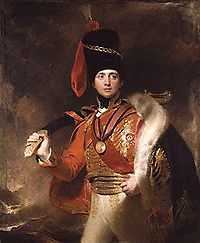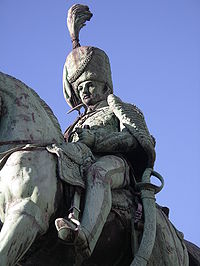- Charles Vane, 3rd Marquess of Londonderry
-
The Most Honourable
The Marquess of Londonderry
KG, GCB, GCH, PC
Minister to Prussia In office
1813–1814Monarch George III Preceded by No representation Succeeded by George Henry Rose Ambassador to Austria In office
1814–1823Monarch George III
George IVPreceded by The Earl of Aberdeen Succeeded by Hon. Sir Henry Wellesley Personal details Born 18 May 1778
Dublin, IrelandDied 6 March 1854
Londonderry House, Park Lane, LondonNationality British Spouse(s) (1) Catherine Bligh
(d. 1812)
(2) Lady Frances Vane-Tempest (d. 1865)Charles William Vane, 3rd Marquess of Londonderry KG, GCB, GCH, PC (18 May 1778 – 6 March 1854), styled The Honourable Charles Stewart from 1789 until 1813 and The Honourable Sir Charles Stewart from 1813 to 1814 and known as The Lord Stewart from 1814 to 1822, was a British soldier, politician and nobleman. He was the only son of Robert Stewart, 1st Marquess of Londonderry, by his second wife Lady Frances, daughter of Charles Pratt, 1st Earl Camden. Robert Stewart, Viscount Castlereagh, was his half-brother. Through his daughter Lady Frances, Lord Londonderry was the great-grandfather of Winston Churchill.
Contents
Political career
Born in Dublin, Charles Stewart (as he then was) was educated at Eton, and at the age of 16 was commissioned into the British Army as a Lieutenant. He saw service in Flanders in 1794, and was Lieutenant Colonel of the 5th Royal Irish Dragoons by the time he helped put down the Irish Rebellion of 1798. Two years later he was elected to the Irish House of Commons as Tory representative for Thomastown, County Kilkenny, and after only two months exchanged this seat for that of Londonderry County. He sat for the latter constituency until the Act of Union in 1801, and represented then Londonderry in the British House of Commons until 1814.
'Fighting Charlie'
In 1803 Stewart was appointed aide-de-camp to King George III, and four years later became Under-Secretary of State for War and the Colonies. During the Corunna Campaign of 1808-1809 he commanded a brigade of cavalry, and played a prominent role in the cavalry clash of Benavente. In April 1809 he was made Adjutant General to Sir Arthur Wellesley (later the Duke of Wellington) with the British forces fighting in the Peninsular War, a post in which he distinguished himself, particularly at the battles of Busaco and Talavera. He received the thanks of Parliament in 1810, and on 20 November 1813 was made Colonel of the 25th Light Dragoons, becoming a Knight of the Bath that same year. Until the end of the war he was Envoy Extraordinary and Minister Plenipotentiary to Berlin, and was also Military Commissioner with the allied armies, being wounded at the Battle of Kulm.
The recipient of numerous foreign honours, Stewart was also, in 1814, ennobled as Baron Stewart, of Stewart's Court and Ballylawn in the County of Donegal.[1] That same year he received honorary degrees from Oxford and Cambridge, was admitted to the Privy Council, and was appointed a Lord of the Bedchamber to the King. He was also made Ambassador to Vienna, a post he held for nine years, and was at the Congress of Vienna with his half brother Lord Castlereagh as one of the British plenipotentiaries, where, according to the renowned historian Adam Zamoyski in his book "Rites of Peace: The Fall of Napoleon and the Congress of Vienna", he made a spectacle of himself with his loutish behaviour, being apparently rather often inebriated, frequenting prostitutes quite openly, touching up young women in public, and once even starting a fist fight in the middle of the street with a Viennese coach driver (from whom he had to be rescued by the Austrian constabulary).
He was appointed GCH in 1816 and made colonel of the 10th (The Prince of Wales's Own) Regiment of (Light) Dragoons (Hussars) on February 3, 1820.
Marriages and Family
His first wife was Lady Catherine Bligh, daughter of the 3rd Earl of Darnley, who he married in 1804; she was three years older than he. She died during the night of 10-11 February 1812, of fever following a minor operation, while her husband was on active service in the Peninsula.
After he married his second wife Lady Frances Anne Vane-Tempest, daughter and heiress of Sir Henry Vane-Tempest, on 3 April 1819, Lord Londonderry took the surname of Vane, by royal licence, and used his new bride's immense wealth to acquire the Seaham Hall estate in County Durham with a view to developing the coal fields there. He also built the harbour at Seaham, to rival nearby Sunderland.
The family also used their new-found wealth to redecorate their main country seat in Ireland, Mount Stewart, and bought Holderness House on London's Park Lane, which they renamed Londonderry House.
Charles Stewart succeeded his half-brother as 3rd Marquess of Londonderry in 1822. The following year he was created Earl Vane and Viscount Seaham, of Seaham in the County Palatine of Durham, with remainder to the heirs male of the body of his second wife.[2]
Governor of County Londonderry from 1823, Londonderry was appointed Lord Lieutenant of Durham in 1842 and the following year became Colonel of the 2nd Regiment of Life Guards. He was finally made a Knight of the Garter in 1853, and died a year later at Londonderry House. Scrabo Tower in Newtownards, County Down was erected in his memory.
He was succeeded as 4th Marquess of Londonderry by his son from his first marriage, and as 2nd Earl Vane by his son from his second marriage.
- George Henry Robert Charles William Vane-Tempest, 5th Marquess of Londonderry (1821–1884)
- Lady Frances Anne Emily Vane (1822–1899); married John Spencer-Churchill, 7th Duke of Marlborough.
- Lady Alexandrina Octavia Maria Vane (1823–1874), godchild of Alexander I of Russia; married Henry Dawson-Damer, 3rd Earl of Portarlington.
- Lord Adolphus Frederick Charles William Vane-Tempest (1825–1864), politician; became insane, and had to be medically restrained.
- Lady Adelaide Emelina Caroline Vane (c.1830–1882); disgraced the family by eloping with her brother's tutor, Rev. Frederick Henry Law.
- Lord Ernest McDonnell Vane-Tempest (1836–1885), fell in with a press-gang and had to be bought a commission in the army, from which he was subsequently cashiered.
References
- ^ London Gazette: no. 16909. p. 1255. 18 June 1814.
- ^ London Gazette: no. 17909. p. 498. 29 March 1823.
Parliament of Ireland Preceded by
George Dunbar
James KearneyMember of Parliament for Thomastown
March - May 1800
With: James Kearney March – April 1800
William Gardiner April – May 1800Succeeded by
William Gardiner
John Francis CradockPreceded by
Thomas Conolly
The Earl of TyroneMember of Parliament for Londonderry County
1800 – 1801
With: The Earl of TyroneSucceeded by
Parliament of the United KingdomParliament of the United Kingdom New constituency Member of Parliament for Londonderry
1801 – 1814
With: Sir George Hill, 2nd Bt 1801–1802
Lord George Thomas Beresford 1802–1812
Hon. William Ponsonby 1812–1814Succeeded by
Hon. William Ponsonby
Alexander StewartMilitary offices Preceded by
Richard WilfordColonel of the 25th Light Dragoons
1813–1818Regiment disbanded Preceded by
George, Prince of WalesColonel of the 10th (The Prince of Wales's Own) Royal Regiment of (Light) Dragoons (Hussars)
1820–1843Succeeded by
The Earl BeauchampPreceded by
The Earl CathcartColonel of the 2nd Regiment of Life Guards
1843–1854Succeeded by
The Lord SeatonPolitical offices Preceded by
Sir George Shee, Bt
Sir James Cockburn, BtUnder-Secretary of State for War and the Colonies
1807 – 1809
With: E. CookeSucceeded by
Hon. F. J. Robinson
Hon. Charles JenkinsonDiplomatic posts Preceded by
No representation due
to the Treaties of Tilsit
(previously John Frere)British Minister to Prussia
1813 – 1814Succeeded by
George Henry RosePreceded by
The Earl of AberdeenBritish Ambassador to Austria
1814 – 1823Succeeded by
Hon. Sir Henry WellesleyHonorary titles Preceded by
The Duke of ClevelandLord Lieutenant of Durham
1842 – 1854Succeeded by
The Earl of DurhamPeerage of Ireland Preceded by
Robert StewartMarquess of Londonderry
1822 – 1854Succeeded by
Frederick StewartPeerage of the United Kingdom New creation Earl Vane
1823 – 1854Succeeded by
George Vane-TempestBaron Stewart
1814 – 1854Categories:- 1778 births
- 1854 deaths
- 5th Royal Irish Lancers officers
- 10th Royal Hussars officers
- British Army personnel of the Napoleonic Wars
- British Army personnel of the Peninsular War
- British Life Guards officers
- Diplomatic peers
- Duellists
- Irish MPs 1798–1800
- Knights Grand Cross of the Order of the Bath
- Knights Grand Cross of the Royal Guelphic Order
- Knights of the Garter
- Lord-Lieutenants of Durham
- Marquesses in the Peerage of Ireland
- Members of the Parliament of Ireland (pre-1801)
- Members of the Privy Council of the United Kingdom
- Members of the United Kingdom Parliament for Irish constituencies (1801–1922)
- Old Etonians
- People from County Dublin
- People of the Irish Rebellion of 1798
- UK MPs 1801–1802
- UK MPs 1802–1806
- UK MPs 1806–1807
- UK MPs 1807–1812
- UK MPs 1812–1818
Wikimedia Foundation. 2010.

